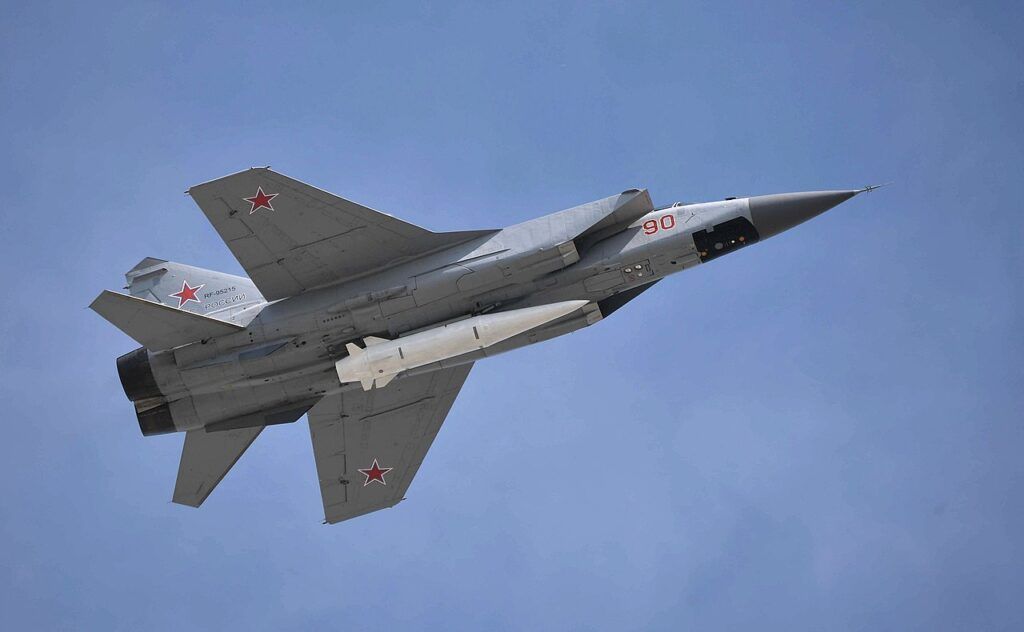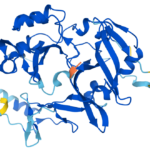Why the alarm over Russia’s use of hypersonic missiles in Ukraine is misplaced
By Andrew W. Reddie | March 31, 2023
 A Russian Kinzhal hypersonic missile carried by a MiG-31K. Photo credit: Russian Presidential Press and Information Office
A Russian Kinzhal hypersonic missile carried by a MiG-31K. Photo credit: Russian Presidential Press and Information Office
Early in March, news outlets reported that almost a year after Russia first used Kinzhal (Kh-47M2) hypersonic missiles in Ukraine, Moscow had used six more of its hypersonic weapons as part of a particularly severe attack that also included Kh-22 anti-ship missiles, S-300 anti-aircraft missiles, and Iranian Shahed drones. Of note, Ukraine’s theater missile defense could not prevent the six Kinzhal missiles—among many of the other missile variants—from getting to their targets. The missile fusillade ultimately caused at least nine civilian deaths.
Perhaps unsurprisingly, this attack led to a substantial increase in reporting about hypersonics, with coverage from the BBC, New York Times, Washington Post, CNN, and NPR among other outlets. The alarmism captured in this reporting indicates the broader misunderstanding concerning the characteristics of hypersonic weapons that matter in both the Ukraine context and (as I wrote earlier in the Bulletin) the broader strategic context involving Washington, Moscow, and Beijing.
This alarmism has two strands.
The first concerns the ability of the Kinzhal missile to evade Ukraine’s air defenses. This is driven by its speed—according to CSIS, the Kinzhal rapidly accelerates to Mach 4 (4,900 kilometers per hour) and can travel as fast as Mach 10 (12,350 km/hr)—and its maneuverability. Regardless of the speed and maneuverability of Russian missiles, the ability of hypersonic and non-hypersonic missiles to make it through air defenses should be unsurprising. In the best case, of course, Ukrainian air defenses would prevent all missile attacks to make it to their target, but missile defense—even at the theater level—remains a difficult technical challenge to conquer. The general ineffectiveness of missile defense technology is not intrinsic to the hypersonic-ness of some of Russia’s missile systems.
Moreover, Russia’s decision to throw one of its most advanced weapon systems at targets in Ukraine when other, cheaper, more “vanilla” capabilities would appear to be sufficient seems a strategic misstep—making some observers wonder why Moscow took this particular decision.
The second strand of alarmism pertains to the perceived imbalance in hypersonic capabilities between the United States on the one hand and Russia and China on the other—exacerbated perhaps by the apparently close ties between Moscow and Beijing.
Robyn Dixon and David Stern’s reporting in the Washington Post is indicative of this concern, noting, “Globally, Russia’s use of the hypersonic missiles—’Kinzhal’ means dagger in Russian—renewed alarm over the Kremlin’s sophisticated arsenal, and it highlighted that Putin possesses difficult-to-intercept, nuclear-capable weapons that the United States and its allies do not yet have.”
The alarm is misplaced.
The notion that the United States is “behind” in the hypersonic weapon arms race is off-base because it fails to consider the varying strategic challenges posed by the current distribution of military capabilities among the United States and its near-peer adversaries.
Indeed, the proposed application of hypersonic weapons by the United States focuses on its conventional rather than nuclear use. As a consequence, the requirements for the weapon system—in terms of its accuracy, for example—are entirely different from those that Russia and China are developing, and, thus, you can expect that their relative technology readiness levels might be different. This is reflected both in the diverging test schedules of hypersonic capabilities and deployment timelines across all three countries.
But perhaps most important is the very different strategic pictures that Washington, Moscow, and Beijing face. Bearing in mind that the primary characteristic of a hypersonic weapon system germane to strategic competition is its maneuverability, which enables it to evade missile defenses, Russia and China’s deployment is perhaps unsurprising given Washington’s focus on developing strategic missile defense (ostensibly focused on North Korea and Iran). If nothing else, the capability represents a hedge against US strategic missile defense systems reaching maturity.
Russia and China do not have a reciprocal focus on missile defense, so there is little that hypersonic weapons would add to the US military’s toolkit that is not already supplied by existing capability. The existing nuclear triad of the United States holds its adversaries at risk, with or without hypersonic delivery vehicles; Russia’s capabilities, with or without its hypersonic capabilities, do the same. Indeed, if speed is the characteristic of interest, then ballistic missiles can reach speeds significantly greater than those of hypersonic weapons. At the margins, research and development spending focused on the latest materials science challenges is appropriate, but hypersonics rhetoric reminiscent of the 1950s “missile gap” is unhelpful.
Clearly, there is something about the “hypersonic” moniker that draws the journalist, the policy-maker, and probably the laboratory scientist, but it serves us to be clear about what the characteristics of these weapon systems are and how they either alter the status quo or do not. In terms of the broader dynamics of strategic competition, these capabilities still do not appear to move the needle—and particularly not if the recent use in Ukraine is representative of the broader use case.
Rather than focusing on “matching” capabilities and engaging in arms-racing behavior, both analysts and policy-makers ought to focus on the consequences for strategic stability of Moscow and Beijing developing these technologies. For example, there are good reasons to think that future variants of hypersonic weapons might evade existing early warning systems—reducing still further the already limited amount of time that civilian leaders have to order a second strike.
Together, we make the world safer.
The Bulletin elevates expert voices above the noise. But as an independent nonprofit organization, our operations depend on the support of readers like you. Help us continue to deliver quality journalism that holds leaders accountable. Your support of our work at any level is important. In return, we promise our coverage will be understandable, influential, vigilant, solution-oriented, and fair-minded. Together we can make a difference.
Keywords: Kinzhal, Russia, Ukraine, hypersonic missiles, missile defense
Topics: Disruptive Technologies, Missile Defense
















Mr. President…we must not allow a bomber gap!
Mr. President…we must not allow a missile gap!
Mr. President…we must not allow a mineshaft gap!
Mr. President…we must not allow a hypersonics gap!
The Military-Industrial-Political Complete never met a “threat” it did not want to pursue.